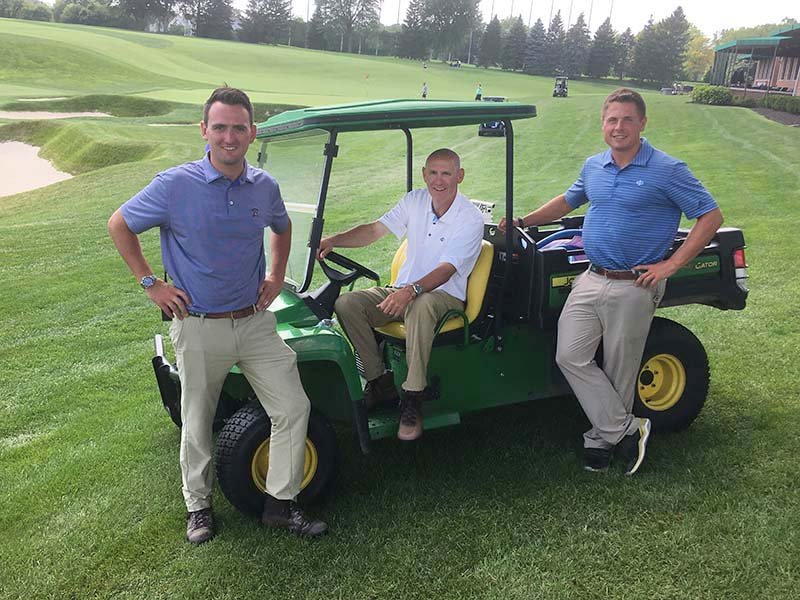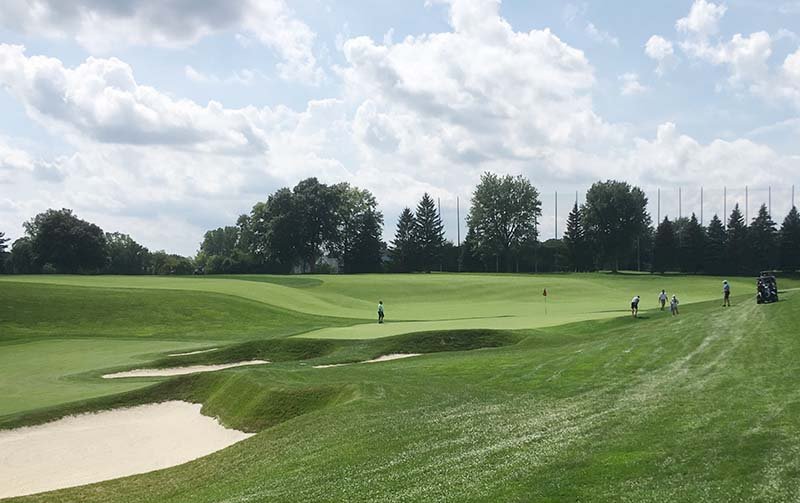A gift from touring golf professionals long ago as a show of thanks to members for their benevolence, the cathedral clock inside the halls at the Inverness Club has been marking the club's history for the past century. For the next two years, it will count down to the historic club's journey back to its place among golf's elite.
A 1918 Donald Ross design, Inverness was the site of four U.S. Open Championships and a pair of PGA Championships, the last in 1993. Through the years, the course has been tweaked a handful of times, each shifting the course farther away from what Ross had intended until finally it had lost its identity if not its historic significance.
After a highly acclaimed restoration at the hands of architect Andrew Green and an aggressive master plan to restore Inverness to its former greatness that included this year's U.S. Junior Amateur, the comeback of what was one of Ross's most revered works is all but complete and will culminate in two years when the 2021 Solheim Cup is contested in Toledo.
"The members love it. They've already forgotten what it looked like two years ago," said Inverness green chairman and past president Greg Kopan, a Toledo-area financial advisor.
"If we'd known how large of a project this was going to be before the U.S. Junior Amateur, I'm not sure we could have sold it. I don't think we could have sold it. We were pushing hard to because we knew it was the right thing to do."

Keeping the project on track while also helping change the culture at Inverness - both on the golf course and in the clubhouse - has been superintendent John Zimmers.
When Zimmers arrived in Toledo two years ago, he brought a lot of championship experience with him after nearly two decades at Oakmont, where he prepped for two U.S. Opens in 2007 and 2016 and a U.S. Women's Open in 2010 and oversaw perpetual changes that transformed the Pittsburgh-area classic from a tree-lined, parkland-style layout into a wide open thing of beauty that looks a lot like what Henry Fownes designed in 1903.
"When I interviewed, I asked them if they realized how aggressive their master plan was," Zimmers said. "It started with taking grass off bunkers, putting in new drainage and sand, then moving bunkers, changing fairways, purchasing land and putting in new golf holes and taking other holes out, building new greens and moving the irrigation lake to where it is now off site, and by the way, take out a few thousand trees, and they probably wouldn't do that project today if they knew what was involved. I haven't heard any regrets, it's just that it was a very large project. And, we never closed the golf course through any of it."
Green was recommended by Zimmers' predecessor Chad Mark, who had a short one-year stint at Inverness before taking the job at Muirfield Village, two hours away in suburban Columbus.
Green's restoration, part of the club's master plan, included restoring some of what Ross had built, rerouting some holes and expanding the course onto recently acquired land. That allowed Green to stretch the course to more than 7,500 yards to keep it relevant for today's longer game while also working within an overall design philosophy to help restore the property to Ross's original intent.
Changes include reworking Nos. 2, 4, 5 and 8. No. 2 is a replica of Ross's original second hole, while 4 is a recreation of the original No. 7, 5 is a replica of the original No. 13 and No. 8 is patterned after the original 6th hole.
Certainly, we would like to see a major back in Toledo. I think Toledo would support it, and now we have the golf course to do it.
Of the hundreds of courses with which Ross's name is associated, Inverness was among his favorites and he wrote of it often.
"I really respect Ross's work," Green told TurfNet last year. "In all my time doing this, and that's about 20 years, you hear numerous things about the courses he did. Did he really do this or that, or was it just a whistlestop tour and they just call it a Ross course?
"The places like Inverness where you know he was on the ground and spent time, he did a marvelous job. He was a genius at fitting holes into the ground he had and being creative to build good golf holes. He had a great eye for utilizing the ground. Each piece of ground was utilized in unique ways, and there was a tremendous amount of variety in his designs.
"All the old guys were good. They didn't need a bulldozer to bail them out."
In more than 20 years of providing championship conditions at the highest level, even Zimmers said he's never quite faced an aggressive schedule like that encountered at Inverness that included the U.S. Junior Amateur just two years after contractor McDonald and Sons broke ground.
McDonald also had been hired by Mark, who is a Zimmers protege. Zimmers had worked with the contractor exclusively for years at Oakmont, and that relationship, along with assistants Ryan Kaczor and Carlton Henry, helped keep the project on track. The end result has been extremely satisfying for Zimmers, especially given the time constraints.
"I don't think there's any question about that. This junior am might be my biggest accomplishment in my professional career," he said. "I'm not going to lie. We didn't have enough time, the grass wasn't mature enough. We didn't have the right equipment, and we didn't have the right staff. Not that there was anything wrong with the staff, we just didn't have enough trained staff. But we worked hard it. We had our ups and downs, and it's something I'm not going to forget. It's not easy doing championships in the middle of July when it's a heat index of 100 degrees.
"The big thing was having two assistants who helped educate the members on what we were doing. The second thing was having McDonald and Sons here. When you work with somebody every day, and I worked with them for the last 20 years, you know they have your back. When you have a relationship like that, they make us look good, and it was up to us bring what they did to life, and I think we've done that."
Held every other year, the Solheim Cup is headed to Toledo in two years. This year's event, won by Team Europe, was played Sept. 13-15 at Gleneagles in Scotland. With the countdown to the next Solheim Cup already begun, there is no rest for Zimmers and his team. LPGA staff have been on site in Toledo for months and preliminary plans for the location of infrastructure already were on Zimmers' desk before the Junior Am was completed.

"I haven't even put my Junior Am folder away, and I already have my first Solheim Cup folder," he said.
Although much of the set up will be at the discretion of the Team USA captain, one change already has been made.
Nos. 9 and 18, the latter being the club's signature hole, will be flipped for the Solheim Cup. The 18th green is where Bob Tway holed out for birdie on the 72nd hole in a rain-plagued 1986 PGA Championship to beat Greg Norman in a Monday finish. In 1920, 43-year-old Englishman Ted Ray placed his putter on the ground there to relight his pipe before sinking a birdie putt on the final day to beat Jack Burke by one stroke and become the oldest U.S. Open champion in history - a mark that stood until Ray Floyd won in 1986 at Shinnecock Hills.
"Everyone will want to see them play 18, and there is a good chance that many of the matches won't get to the 18th hole. So, if they never show up to 18 it will be disappointing," Zimmers said. "I understand it. Being a traditionalist, I don't like it, but it is the right thing to do. I want to see them play that hole."
If we'd known how large of a project this was going to be before the U.S. Junior Amateur, I'm not sure we could have sold it.
Inverness has a longstanding tradition with major championship golf. The U.S. Open was contested there in 1920, 1931, 1957 and 1979. The club also was site of the PGA Championship in 1986 and again in 1993.
In golf's early days, touring professionals traditionally were prohibited from using a club's facilities. That all changed in 1920 at the U.S. Open in Toledo when Inverness opened its dressing room doors to the players. As a show of thanks, the tour pros, headed by Walter Hagen, gifted the club with a cathedral clock that still keeps time in the clubhouse today.
While the club maintains a tie to major championship golf, the city of Toledo has an equally impressive legacy with women's golf. The town has hosted an LPGA event since 1984. Marathon Petroleum, the title sponsor of the LPGA event, also has signed on to back the Solheim Cup.
And if the opportunity to host a U.S. Open or PGA Championship would ever present itself, Inverness now has the golf course to pull it off thanks to Green, Zimmers and a patient and dedicated membership willing to make it all happen.
"The club has always wanted to be there," Kopan said. "We needed to make some improvements and move forward. The moment we made the decision to move forward, the goal was always to do events of national prominence. We want to do bigger and bigger tournaments. We want to continue to do national events, and in the case of the Solheim Cup, international events. Certainly, we would like to see a major back in Toledo. I think Toledo would support it, and now we have the golf course to do it."


